By SYDNEY J. FREEDBERG JR
 WASHINGTON: Call it the once and future king of battle. The Army’s artillery branch, neglected over 20 years of hunting guerrillas, is being revived as the long-range striking arm for multi-domain warfare against Russia and China. That will affect everything from what missiles the service buys, to which officers get promoted, to how the service organizes itself for battle – a force structure outlined in a new Army Futures Command study called AimPoint.
WASHINGTON: Call it the once and future king of battle. The Army’s artillery branch, neglected over 20 years of hunting guerrillas, is being revived as the long-range striking arm for multi-domain warfare against Russia and China. That will affect everything from what missiles the service buys, to which officers get promoted, to how the service organizes itself for battle – a force structure outlined in a new Army Futures Command study called AimPoint.
The biggest change? Having already created two experimental Multi-Domain Task Forces built around artillery brigades, the Army now plans to build new high-level headquarters called Theater Fires Commands to coordinate long-range missile warfare on a continent-wide scale.
“That is a direct output of AimPoint,” said Lt. Gen. Eric Wesley, whose Futures & Concepts Center developed the force structure plan. While the Theater Fires Commands do not exist yet, he said, the service has already begun setting aside manpower in its Total Army Analysis process to staff them.
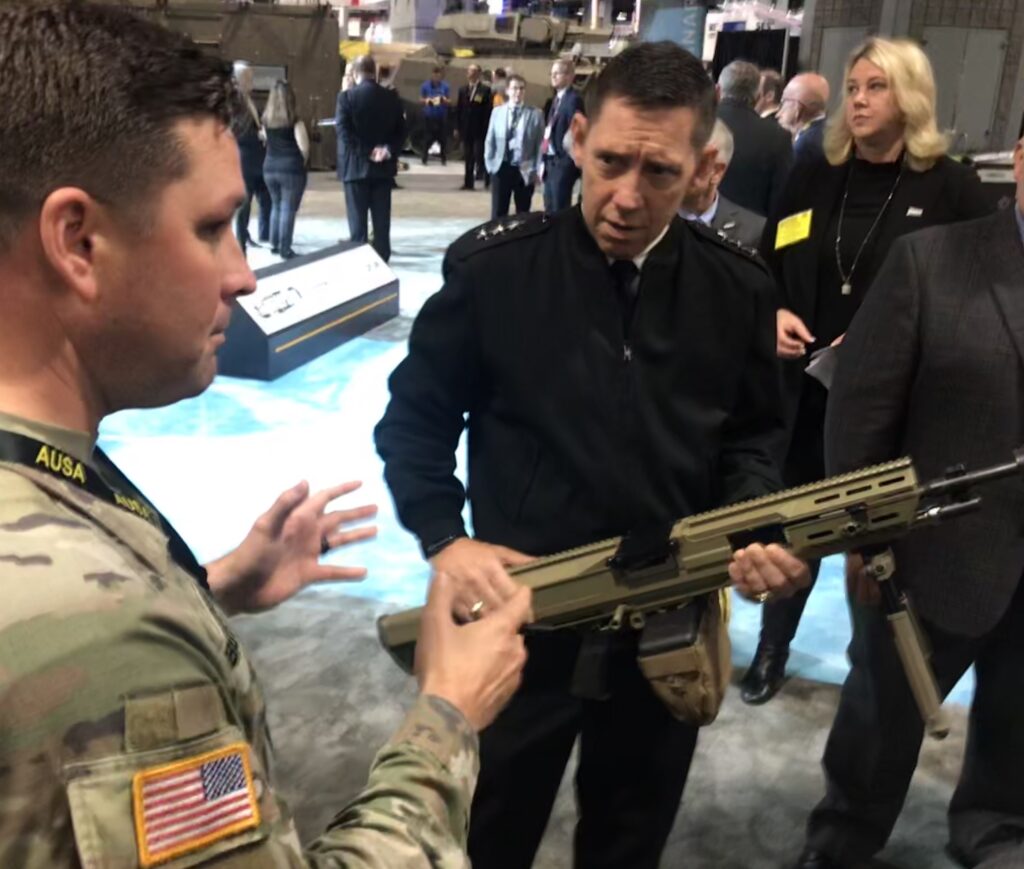
Lt. Gen. Eric Wesley checks out a prototype for the Next Generation Squad Weapon
In AimPoint’s vision of the future, “the brigades largely look very similar to what you might see right now… except for your [increased] ability to connect to national assets” in space and cyberspace, Lt. Gen. Wesley told reporters last week in a wide-ranging discussion. (Read more here). The big changes, he said, will come at higher levels – division, corps, and theater command – that have largely played a supporting role in highly localized counterinsurgency operations, but which must take the lead in coordinating large-scale campaigns against well-armed nation-states.
“If you look at echelons above brigade, what we’re having to do is build out our capacity to fight large-scale, campaign-quality combat,” he said. “Those echelons we have mortgaged a bit in the last 20 or 30 years because our BCTs [Brigade Combat Teams] were so powerful relative to our opponent. [Today], because we are being contested in all domains and our two peer competitors are investing in their militaries, we have to build back some of that campaign quality at echelon, with the distinction being you’ve got to have information warfare, you’ve got to have cyber, you’ve got to have space access.”
 Once the shooting starts, however – and even before, when you’re trying to deter the other side from shooting at all – you still need old-fashioned firepower, with a 21st century twist.
Once the shooting starts, however – and even before, when you’re trying to deter the other side from shooting at all – you still need old-fashioned firepower, with a 21st century twist.
Artillery has been a US Army strength since World War II, when its ability to quickly coordinate far-flung howitzer batteries to pour overwhelming fire on a chosen target was one of the few things the German Wehrmacht feared. But back then, and even throughout the Cold War, the limits of radio networks, artillery range and precision targeting meant artillery could only be decisive on the tactical level, supporting the face-to-face battle of infantry and tanks.
Today, however, the precision-guided missiles that the US, Russia, and China are developing have such long ranges – hundreds or thousands of miles – that you need satellites to spot suitable targets and send back targeting data, plus superior cyber warriors to protect that communications network from hostile hackers. Bringing all those technologies together in the right organization with well-trained personnel, and artillery can make a decisive impact on theater-wide operations or even the strategic level.
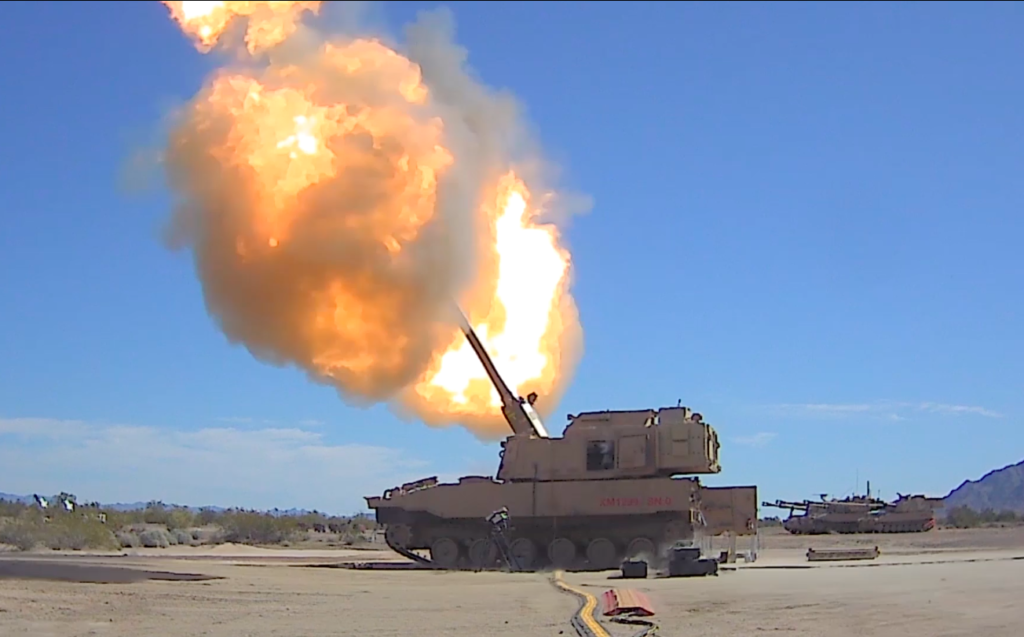
The prototype M1299 armoured howitzer test-firing at Yuma Proving Ground on March 6, 2020.
Dead Branch Resurrecting?
But there’s a problem. Over the three decades between the end of the Cold War and the reawakening to Russian and Chinese threats, the Army neglected its artillery branch. In 2002, the Army actually disbanded the artillery brigades in its divisions and dispersed their component battalions across its armor and infantry brigades. Then, in Afghanistan and Iraq, US firepower was so overwhelmingly superior, and air support was so readily available for even small patrols, that artillery troops rarely got to fire their guns, even in training, and were routinely retasked for other duties. By 2008, three artillery colonels co-wrote a paper that called their arm of service a “dead branch walking.”
Approximate ranges in miles between the Russian enclave in Kaliningrad and select NATO capitals. SOURCE: Google Maps
Meanwhile, Russian and Chinese howitzers, rocket launchers and surface-to-surface missiles came to not only outnumber but also outperform their aging US counterparts. That led Lt. Gen. Wesley’s predecessor as the Army’s chief futurist, Lt. Gen. H.R. McMaster, to tell Congress in 2016 that “we are outranged and outgunned.” The next year, in October 2017, the Army officially made Long-Range Precision Fires its No. 1 modernization priority.
Now the Army is urgently developed new artillery systems, from rocket-boosted, precision-guided howitzer shells with a range of 40 miles, to 300-plus-mile tactical missiles, to hypersonic weapons that can fly thousands of miles at more than Mach 10. But technology alone is not enough.
After two decades of its soldiers rarely getting to use artillery, the Army now needs experienced gunners to run its new high-level Fires Commands and make the most of its new long-range missiles. Sure, infantry and tank brigade commanders can call in strikes on the targets they see in front of them in a tactical fight. But it takes senior artillery officers and experienced, specialist staff to choose the most critical targets for an entire theater of war and to coordinate long-range strikes over hundreds of miles. While the Army recreated division-level artillery headquarters in 2014, it is now studying long-range fires commands at the corps and theater levels.
What’s more, the different theaters will require a different mix, not only of artillery systems, but of all the supporting players being developed as part of the Army’s “Big Six”: Long-Range Precision Fires, Next Generation Combat Vehicles, Future Vertical Lift, Networks, , Air & Missile Defense (also an artillery branch mission), and Soldier Lethality gear.
Approximate ranges in miles from Chinese territory to select US and allied targets. SOURCE: Google Maps
For Indo-Pacific Command, focused on the Chinese threat, the vast expanse of ocean means the Army must support the Navy. That means long-range artillery batteries – very long range, given the distances involved – based on friendly islands to control the surrounding sea lanes, forming unsinkable anvils for the Navy’s highly mobile hammer. But, Wesley said, that also requires advanced air and missile defense systems to blunt the enemy’s own long-range salvos, long-range high-speed aircraft to move ground forces from island to island and a sophisticated, secure network to coordinate it all.
In Europe, by contrast, the distances are shorter – requiring a different mix of missiles – and ground combat is the central front, with small and largely landlocked seas on either flank. That makes armored ground vehicles and soldier gear, from new rifles to targeting goggles, much more important than in the Pacific.
Those profound differences mean the Army cannot create a single universal unit with one set of equipment that can adapt to every situation, as the cancelled Future Combat Systems program once attempted. Even if a one-size-fits-all Army somehow made sense tactically, Wesley said, it wouldn’t work out technologically. With rapid advances in computing affecting everything from targeting to logistics, there’s no way to develop a new piece of equipment, mass-produce it and issue it to every brigade across the Army before something new and better comes along. Instead of “pure fleets” where every brigade has the same software, trucks, missiles, etc., organized in the same way, the Army must tailor its forces to the theater.
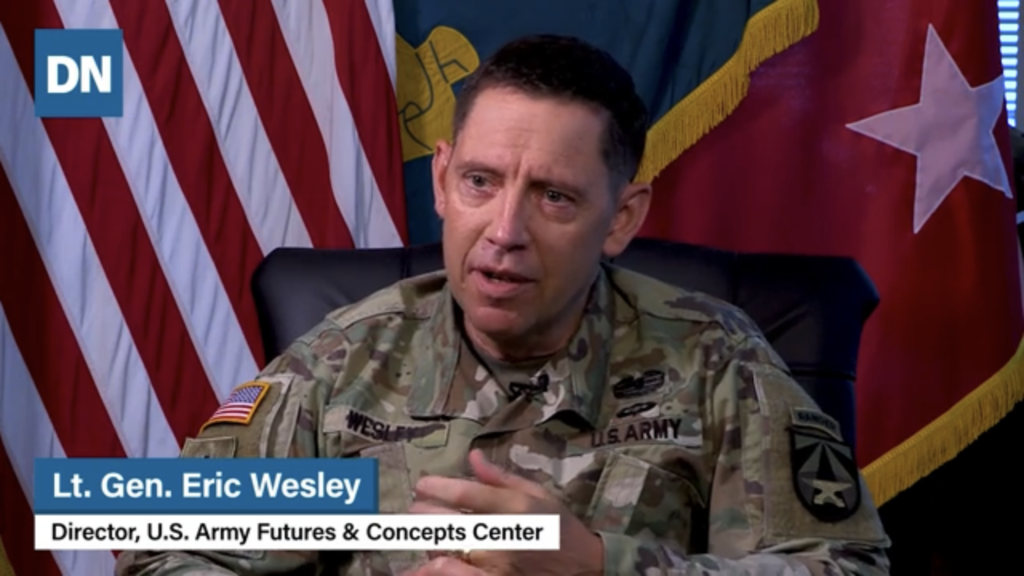
Lt. Gen. Eric Wesley
For more from Lt. Gen. Wesley in his own words (edited for brevity and clarity), read on:
Q: Historically, the Army has always wanted to standardize equipment, training, and organization as much as possible – after all, “G.I.” stands for “General Issue.” But Europe and the Pacific are very different. Do you need more of a mix of forces across the Army?
A: The world and technology are moving too fast to believe I’m going to get Technology One in every single brigade [before Technology Two makes it obsolete]. We have to be more agile than that. Pure fleeting and even pure structuring is probably not an acceptable approach.
Second, the reality is there are two pacing threats that we’re looking at, and they’re distinctly different, the geography is different, and so we have to consider different ways to approach those problems. You can expect that the force package we build for INDOPACOM will be distinct from the force package we build in Europe.
Where there’s commonality is in Multi-Domain Operations. MDO is a way of fighting, and I think you’re going to see that way of fighting be consistent in both theaters, but the application of it will be different.
What are those distinctions? In INDOPACOM, fires to help the Navy control sea lanes are indispensable. In Europe, the essence of the problem is the ability to conduct a very advanced ground maneuver effort.
Those [Big Six] priorities that we identified are pretty consistent with what most of the data and analytics and the rigor of the experimentation we look at – those priorities are priorities for a reason. But if you look at the theaters, those priorities might look a little different.
So in INDOPACOM, fires, air and missile defense, and the network are some of the really critical pieces, and Future Vertical Lift, I would argue. If you look to Europe, it’s going to be long range fires, the network, next generation combat vehicles, and soldier lethality.
Q: How are you designing that future force?
A: Gen. Milley [the 39th Army Chief of Staff, from 2015 to 2019], asked us, in a perfect world, what that force looks like. [He] asked us to build a resource-unconstrained design that reflects the precepts and principles of multi-domain operations. That was affectionately called the White Board Force.
CSA 40 [the new Chief of Staff, Gen. James McConville] and Gen. Murray, the AFC commander, asked us to do a resource-informed design. That’s what is called the AimPoint. It tightens the shot group and it allows us to define our experimentation, analysis, and programming better.
When you’re resource-unconstrained, you can go out and buy a Maserati. When you’re resource-informed, you might buy a Corvette. We just had to throttle back on some of the ambitious desires we were looking for. We’re on a [trajectory] to 492,000 [active duty soldiers]: How would you organize that in order to achieve MDO?
AimPoint is not a locked down design that everybody has to invest in and build towards now. It’s really an architect’s design, and now we have to get into the detailed engineering and blueprint of it.
We need an enhanced posture forward in both INDOPACOM and in Europe – nothing like the 1980s, but larger than what we have now. That’s obviously going to be informed by resource decisions, but already the Army [is reactivating] an additional corps headquarters with an operational command post forward [in Europe].
Q: How will the AimPoint Army be organized differently to fight?
A: The brigades largely look very similar to what you might see right now, because you still have to shoot, move, and communicate. BCT [Brigade Combat Team] and below, what you see won’t change a lot — except for your ability to connect to national assets. Why is that? Well, we’re fighting multi-domain, which means access to cyber, access to space assets, in certain instances at the tactical level. You have to have the plugs to get connect to national assets.
If you look at echelons above brigade, what we’re having to do is build out our capacity to fight large-scale, campaign-quality combat. Those echelons we have mortgaged a bit in the last 20 or 30 years because our BCTs were so powerful relative to our opponent.
[Today], because we are being contested in all domains and our two peer competitors are investing in their militaries, we have to build back some of that campaign quality at echelon, with the distinction being you’ve got to have information warfare, you’ve got to have cyber, you’ve got to have space access. So in each echelon you would have that capacity to fight all domains and integrate them.
Each echelon has distinct problems that has to be solved in order to enable the force to get to a position of advantage. Sometimes that requires each echelon to have distinct capabilities.
Competition [short of war] is the first joint problem that has to be solved. Frankly, a brigade commander cannot provide the resources, the solutions, and the decisions made, to compete with a peer competitor. That’s got to be retained at the three- and four- star level.
In the event of conflict, it requires long range fire to strike the Russian combined arms army or Chinese equivalent. Again, that BCT commander would not necessarily have either the assets or the authority to strike the targets we’re talking about with long range fire. So you have to do that at a different echelon.
There are problems that the BCT commander does not solve for the theater, and some of that needs to be done at echelon.
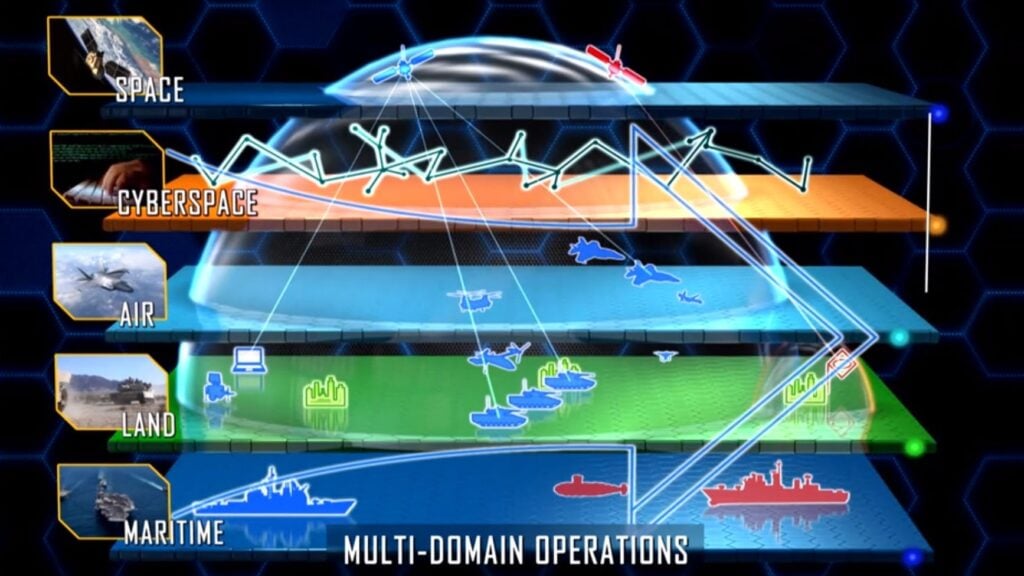
Multi-Domain Operations envisions a new collaboration across land, sea, air, space, and cyberspace (Army graphic)
Q: What kinds of higher-echelon capabilities from the Cold War era are being recreated, like corps level artillery formations?
A: Building out the ability to integrate fires at echelon is really important to being able to fight at scale.
When we went to modularity, with the BCT being the coin of the realm, we moved the artillery fires battalion [out of the division-level artillery brigade] into the BCT. Now what you’re going to see is the need to return to some aspects of centralization of fires, with the ability to decentralize [as needed], which makes the problem even harder.
So, how have we done that? Well, for example, you saw a couple of years ago that we went back into the [division-level] fires brigade. That might be further reinforced as we go forward.
Then the theater fires command, as an example, that is a direct output of AimPoint. In the last TAA [Total Army Analysis] cycle, we started to [set aside] a wedge of structure that we can design against. So that does not exist [yet].
Q: What are you able to do in the near term? You already have one experimental Multi-Domain Task Force in the Pacific and another being stood up in Europe.
A: We’ve got AimPoint, we’ve got this orientation to the future, but General McConville said, ‘hey, I want to get stuff out there now, because the customer needs it, and that is the capacity to penetrate with long range fires, with the ability to integrate all domains.’
That is what a MDTF is, and we’re building them right now, and we want to get them into each theater. As we deploy those, we’re going to learn lessons on how they best connect with the joint force. You may see, for example, an MDTF subordinate to a theater fires command or subordinate to a corps fires element. Right now, they’re individual [units] that are being built; we will experiment with them and learn how they plug in, but ultimately you’re going to see that capability migrate to the [higher] echelons.
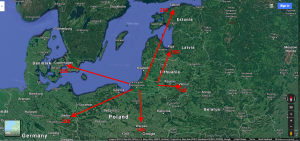
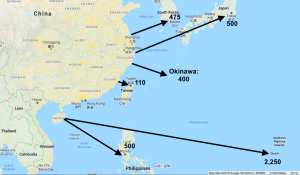
No comments:
Post a Comment